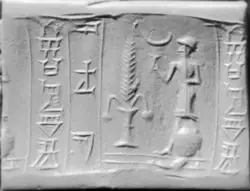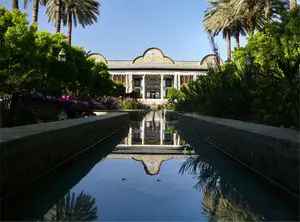How did the concept of paradise develop
The idea of paradise is today associated with the major monotheistic religions. However, the roots of this concept are more complex and developed from earthly ideas and religious structures.
Early Developments
In early Sumerian civilization, deriving from ancient Mesopotamia, the gods were seen as living in a garden secluded from humans.[1] In the story of Gilgamesh, one of the world’s first epic tales, it describes the hero Gilgamesh traveling to a garden, far away from human civilization, to find the Utnapishtim. This man is the equivalent and likely influenced the development of the Biblical Noah, as in both stories he was saved from a great flood by building a large boat to save himself, his family, and various animals.[2] In the case of Gilgamesh, as Utnapishtim was allowed to live forever, Gilgamesh travels to see him so that he too can find eternal life. Paradise is also described not just as a place of plants and gardens but also having precious stones and pearls. In summary, it is a place filled with luxurious objects and beautiful. A very early tablet that discuses the domain of the gods describes it as a garden, reflecting that gardens and paradise were linked at the outset.[3] In different mythologies and stories, potential locations of the gods could be in Mesopotamia, Dilmun (now Bahrain), Lebanon, or perhaps other places. While it is debatable what the region was or where it is in the minds of the Sumerians, it is clearly associated as a peaceful and beautiful setting where the gods reside away from humans. [4]
This concept of garden and a sacred place for the gods continued from the 3rd to 1st millennium BCE and influenced practical architectural developments in sacred structures. Very likely temples built during this time often had gardens within their compounds, although the gardens have not preserved where temples have been excavated. [5] Despite the lack of preservation, we often see large spaces between the physical temple structure, in this example a ziggurat to the god Marduk at Babylon, and an enclosure wall (Figure 1). This could suggest that the space between the temple structure and wall was a garden that likely represented the sacred dwellings area of the gods and the holy structure inside was the inner sanctuary where the god resided. Additionally, in this garden, although little is still known about its meaning, the concept of a sacred Tree of Life is developed in Sumerian mythology. This concept is likely to have been very similar to the Tree of Life found later in the Bible (Figure 2).[6]
Paradise Developments
The word “paradise” derives from an Akkadian and Persian word (pardesu is Akkadian) and (paridayda in Old Persian). [7] The term seems to specifically deal with structures or enclosures, perhaps associated with the walled gardens of temples discussed earlier. Soon, however, these gardens began to be found in other areas, including palaces or as pleasure gardens for royalty. In other words, the concept of gardens as an ideal setting spreads to more secular structures. In fact, gardens became very popular as royal areas in the Neo-Assyrian \and Neo-Babylonian Empires (9th-6th centuries BCE), spreading to the different Persian empires, such as the Achaemenids, Parthians, and Sassanians, who eventually influence Islamic empires and states that arose in the 1st millennium CE. We can still see these gardens as they were envisioned by the Persians today (Figure 3).

With the arrival of the Greeks in the Near East at the time of Alexander the Great, the Akkadian/Persian term is utilized by the Greeks, who now associate this term as a garden with animals and begin to adopt it as part of their culture. [8] This perhaps reflects the change that these gardens underwent, from generally being associated with temple architecture to also becoming royal parks enclosed in areas for kings in Western societies. The concept of royal garden develops further in Rome, and begins to be found in their great palaces and large houses, spreading to various parts of Europe.
For the developing religions of the 1st millennium BC and later, in particular Hebrew and Zoroastrianism, the concept of paradise begins to develop. We see in the Hebrew Bible the story of Genesis most representing what this paradise looks like, as a place where pre-sinful Adam and Eve resided along with animals and the Sacred Tree of Life and Tree of the Knowledge of Good and Evil. Early Christianity and Islam also develop concepts of paradise as gardens that the righteous will dwell in. [9]
Modern Understanding
Modern usage of paradise shifts between an earthly place or heavenly realm. Interestingly, however, the concept of perfection, first displayed by the Sumerians, is retained. That perfection was demonstrated as gardens, with animals and precious stones in Mesopotamian and Persian understanding. In fact, this idealized setting still dominates our concepts of a sacred place. This is also true for more secular reasoning, as gardens or trees are often used to describe areas many cultures consider as a type of paradise. For example, Hollywood movie depictions tend to have this ideal, garden-filled setting as a form of paradise.[10]
Conclusion
The road that eventually forms our religious and secular understanding of paradise seems to have an origin in ancient Sumer, where gardens are first descried as the sacred dwelling place of the gods. That mythology had a practical part in developing gardens in temples and later in palaces and royal parks. In fact, this is also the origin of our modern garden parks, although these have now become more secular in concept. Nevertheless, the Sumerian, Akkadian, and Persian concepts of paradise begin to influence the major religions that we have today. Those religions, in turn, influence more secular concepts of an idyllic place, often having trees or some seclusion.
References
- ↑ For more on gardens and Sumerian beliefs, see: Kramer, Samuel Noah. 1995. The Sumerians: Their History, Culture, and Character. 12. [pr.]. Chicago: The Univ. of Chicago Press.
- ↑ For more on the Epic of Gilgamesh, see: Sandars, N. K., ed. 1977. The Epic of Gilgamesh. Revised ed., incorporating new material. Penguin Classics. Harmondsworth ; New York [etc.]: Penguin.
- ↑ For more on this early tablet from c. 2600 BCE Kish, see: Barton, George Aaron. 1918. Miscellaneous Babylonian Inscriptions. Yale University Press. p. 52.
- ↑ For information on the location of paradise in the minds of Sumerians, see: Luttikhuizen, Gerard P., ed. 1999. Paradise Interpreted: Representations of Biblical Paradise in Judaism and Christianity. Themes in Biblical Narrative, v. 2. Leiden ; Boston: Brill.
- ↑ For more on temple gardens, see: Wiseman, D. J. 1983. “Mesopotamian Gardens.” Anatolian Studies 33 (December): 137–44
- ↑ For more on the Tree of Life, see: James, E.O. 1966. " Tree of Life: An Archaeological Study. Studies in the History of Religion. Brill.
- ↑ For more on the origins of the term "paradise" and its meaning, see: Bockmuehl, Markus N. A. 2010. Paradise in Antiquity: Jewish and Christian Views. Cambridge [u.a.]: Cambridge Univ. Press.
- ↑ For more on the Greek concept of gardens and paradise, see: Aben, Rob, and Saskia de Wit. 1999. The Enclosed Garden: History and Development of the Hortus Conclusus and Its Reintroduction into the Present-Day Urban Landscape. Rotterdam: 010 Publishers. Pg. 249.
- ↑ For more on the development on the concept of paradise in universal religions such as Islam, Christianity, and Zoroastrianism, see: Ellens, J. Harold, ed. 2013. Heaven, Hell, and the Afterlife: Eternity in Judaism, Christianity, and Islam. Psychology, Religion, and Spirituality. Santa Barbara, California: Praeger, an imprint of ABC-CLIO, LLC.
- ↑ For example, see: Dixon, Wheeler W. 2006. Visions of Paradise: Images of Eden in the Cinema. New Brunswick, N.J: Rutgers University Press.
Maltaweel, Admin, Kestrel10 and EricLambrecht
Related DailyHistory.org Articles
- What was Plato's academy and why did it influence Western thought?
- Alexander the Great Top Ten Booklist
- Why was Alexander the Great So Successful In His Conquests?
- What Factors Led to the Creation of the First Cities?
- Thomas Jefferson, the Founding Fathers and Christianity: Interview with Sam Haselby


